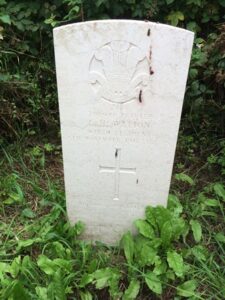Eglwys Dewi Sant or St David’s Church, was an Anglican parish church in the town of Carmarthen, built to cater for the Welsh speaking population of the town. The Church was originally to be built on the site now occupied by Christ Church, but following an argument with the land owner following the laying of the foundation stone on 27 November 1824, the offer of the land was withdrawn.
Despite this delay, the new Church was built on Picton Terrace, Carmarthen between 1835 and 1837 and its first services were held on 19 January 1837. The Church was officially consecrated by Bishop Thirlwall on 3 February 1841.
Storm damage in November 2003 caused the closure of the church, which was sold for a nominal value in 2011 and is to be converted into a private dwelling.
Within the now closed St. David’s Church was a fine wooden war-shrine which was originally dedicated in February 1917 to hold the names of all of the parishioners who served during the Great War. At the time of its dedication over 350 parishioners were serving out of a congregation of 2,000 people and by the end of the war contained 611 names. This shrine has now been relocated into Christ Church. I have not yet had the time to annotate all of the names, but the shrine is pictured below. The details will be added once I have managed to decipher the names.
The Parishioners of St. David’s also raised funds and contributed to the building of a War Memorial Hall, located at the junction of Morfa Lane and Picton Terrace. The hall was opened on 16 November 1921, but was later sold to HTV Wales to use as a TV Studio.
There are several war graves within St. David’s Churchyard, including one to one of the towns most gallant soldiers. Details of these can also be seen below.
St. David’s Parishioners War Shrine
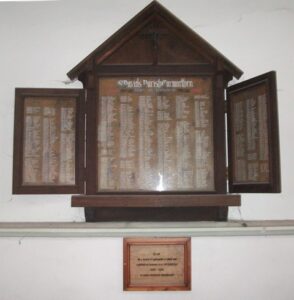
Great War Military Burials in St. David’s Church Cemetery
Henry Evans, Gunner, 42398, Royal Garrison Artillery. Henry was the son of John and Sarah Evans, of 3, Glannant Road, Carmarthen. He enlisted at Carmarthen on 18 August 1914 into the Royal Garrison Artillery. He was sent to France on 2 June 1915, attached to the 13th Heavy Battery, which soon moved to Salonika. Henry became ill at Salonika, and spent a short period of time recuperating before rejoining his battery. He again fell ill, and was brought back to Britain aboard the Hospital Ship Essequito, and was discharged from Gosport on 18 July 1916 as being deemed unfit for further military service. Henry died of tuberculosis contracted through his service overseas on 23 June 1917, aged 25. He was buried in St. David’s Churchyard by Reverend Griffith Thomas on Wednesday 27 June. His mother had to suffer the triple tragedy of losing three members of her immediate family within months of each other: Her husband, John died in May, Henry in June and her second daughter Ethel Mary in September 1917.
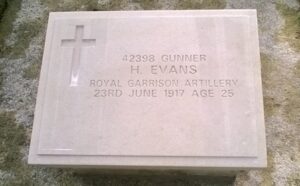
Richard Austin Evans, Sergeant, 200828, Welsh Regiment. Richard was the son of Thomas and Elizabeth Evans, of 29, Catherine Street, Carmarthen. He originally served with the 1/4th Battalion, Welsh Regiment, which was the local Territorial Battalion, attached to 159 Brigade, 53rd (Welsh) Division. The Division landed at Cape Helles, Gallipoli, on 9 August 1915, and was immediately thrown into action, spending the next few days in isolated pockets, fighting against a Turkish counter-attack during the Battle of Sari Bair, and then at the Attack on Scimitar Hill. The Division remained here throughout the coming months, and suffered severe losses in manpower strength during the great November 1915 blizzard on Gallipoli, when its total strength was reduced to less than that of a full-strength Brigade. On 11 December 1915 the Division was evacuated to Mudros, and by 23 December 1915 were moved to Egypt. They remained on the Suez Canal Defences for the next twelve months, where it took part in operations against the Sultan of Darfur, and in March 1917 took part in the advance into Palestine. On 30 July 1918 the 1/4th and 1/5th Welsh were again merged, forming the 4/5th Battalion and they remained in Palestine until leaving for the UK on 31 October 1918. Richard had served as the regimental shoemaker during his time at war. He was taken ill on the way home from Egypt in March 1919 and sadly died of disease at home on 6 August 1919, aged 27. He was buried with full military honours by the Reverend Gwynfe Jones in St. David’s Churchyard on Saturday 9 August. Photograph courtesy of David Wilson-Pinkney.
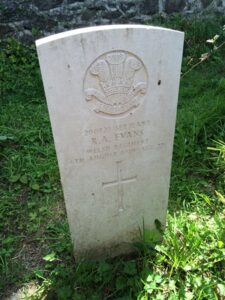
Alfred Goble, Sergeant-Instructor, 16487, Welsh Regiment. Alfred was born at Worthing, Sussex, the son of John and Mary Ann Goble. He was an experienced old soldier, and had taken part in the Retreat to Kandahar in 1880, under Lord Roberts. He married Susan Douglas in 1885, and moved to Carmarthen many years before the Great War, as instructor for the Royal Garrison Artillery. As soon as war broke out, Alfred was anxious to do his bit once again, and after a period at the Army Remount Depot at Carmarthen, he joined the 15th Battalion, Welsh Regiment on 21 February 1915, which was then at Rhyl. The battalion was later known as the Carmarthen Pals. Alfred didn’t go to France with the battalion, but remained at Kinmel Park as an Instructor with the 61st Training Battalion. His health deteriorated under the strains however, and he died in hospital at Kinmel Park on Thursday 31 May 1917, aged 64. His body was transported by rail to Carmarthen and Alfred was buried in St. David’s Churchyard by Reverend Griffith Thomas on Tuesday 5 June. He left a widow, four daughters, and four sons, two of whom were serving with the Army.

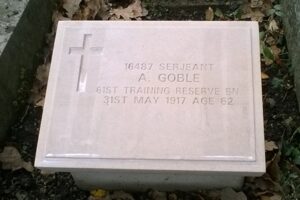
Brighty Thomas Lewis, Private, 201128, Welsh Regiment. Brighty was the son of David and Jane Lewis, of Carmarthen. In 1912 he married Florence Evans, of 47, Mill Street, Carmarthen. He enlisted at Carmarthen into the 1/4th Battalion, Welsh Regiment, which was the local Territorial Battalion, attached to 159 Brigade, 53rd (Welsh) Division. The Division landed at Cape Helles, Gallipoli, on 9 August 1915, and was immediately thrown into action, spending the next few days in isolated pockets, fighting against a Turkish counter-attack during the Battle of Sari Bair, and then at the Attack on Scimitar Hill. The Division remained here throughout the coming months, and suffered severe losses in manpower strength during the great November 1915 blizzard on Gallipoli, when its total strength was reduced to less than that of a full-strength Brigade. On 11 December 1915 the Division was evacuated to Mudros, and by 23 December 1915 were moved to Egypt. They remained on the Suez Canal Defences for the next twelve months, where it took part in operations against the Sultan of Darfur, and in March 1917 took part in the advance into Palestine. Brighty served throughout the war, until being wounded on 13 July 1918, and had to have a leg amputated. He returned home, but his wound and the strain of years of overseas service took a toll on his health and he died in Carmarthen on 22 February 1919, aged 28. Brighty was buried with full military honours in St. David’s Churchyard on Tuesday 25 February by Reverend E. Basil Herbert. Photograph courtesy of David Wilson-Pinkney.
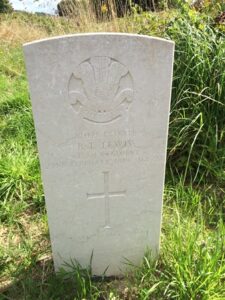
William Archibald Tucker Morris, DCM, Sergeant, 14582, Welsh Regiment. William was the son of Philip and Mary Morris, of Island Wharf, The Quay, Carmarthen. He was an old soldier, who had fought in the Boer War of 1899-1901, and at the outbreak of war went to France with the 2nd Battalion, Welsh Regiment, who were attached to 3 Brigade, 1st Division. William fought with the Division during the retreat from Mons to the Marne, where the Germans were stopped. After a famous action at Chivy sur Aisne, the 2nd Welsh moved to Ypres, and made a famous stand at Ghelulveldt during the First Battle of Ypres, where they again stopped the German Offensive. The following year saw them in action again at the Battle of Aubers, before taking part in the Battle of Loos, and the action at the Hohenzollern redoubt. In 1916 the Division moved south to the Somme, and fought at the Battles of Albert, Bazentin, Pozières, Flers-Courcelette and Morval. William was awarded his Distinguished Conduct Medal and the Order of St. George of Russia for Gallantry on the Somme during the Battle of Pozières, on 25 July 1916, when he remained at his post, although wounded, and helped repulse a German counter-attack. He returned home to Cambridge for treatment, and was presented with his medal in Hospital there. He refused to take up a post as an instructor after recovering, and instead returned to the 2nd Welsh, who had moved to the Flanders Coast during the summer of 1917, prior to taking part in the Second Battle of Passchendaele. After spending another winter in Flanders, they were near Estaires when the German Spring Offensive caught them, and William was severely wounded here. He was brought back to the UK for treatment at the 1st Southern General Military Hospital, Birmingham, but sadly died of wounds there on 2 May 1918, aged 38. William’s body was brought home to Carmarthen for burial with full military honours in St. David’s Churchyard on Tuesday 7 May by Reverend Griffith Thomas. Photograph of his grave courtesy of David Wilson-Pinkney.
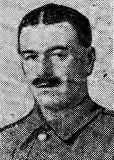
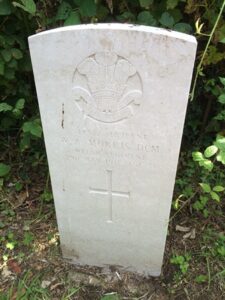
George Herbert Walton, Private, 200940, Welsh Regiment. George was the son of William Harrison Walton and Mary Walton, of 73A, Lammas Street, Carmarthen. He enlisted at Carmarthen on 1 November 1913 into the 4th Battalion, Welsh Regiment, which was the local Territorial battalion. George doesn’t seem to have served overseas, but took ill while in camp at Dale, and was discharged with a pension from the 4th Welsh as unfit on 13 September 1917, returning to Carmarthen. His health had never recovered from his time in khaki in Pembrokeshire, and George died of pneumonia on 5 November 1918, aged 25. He was buried in St. David’s Churchyard on Friday 8 November by the Reverend B. Davies, MA. Photograph courtesy of David Wilson-Pinkney.
